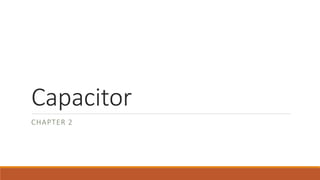
Capacitor (1).pptx
- 2. Capacitor The capacitor is a component which has the ability or “capacity” to store energy in the form of an electrical charge producing a potential difference (Static Voltage) across its plates, much like a small rechargeable battery. https://www.electronics-tutorials.ws/capacitor/cap_1.html https://www.youtube.com/watch?v=X4EUwTwZ110&t=8s
- 3. Capacitor In its basic form, a capacitor consists of two or more parallel conductive (metal) plates which are not connected or touching each other but are electrically separated either by air or by some form of a good insulating material such as waxed paper, mica, ceramic, plastic or some form of a liquid gel as used in electrolytic capacitors. The insulating layer between a capacitors plates is commonly called the Dielectric
- 4. Capacitor-Types and Applications Air - Often used in radio tuning circuits Mylar - Most commonly used for timer circuits like clocks, alarms and counters Glass - Good for high voltage applications Ceramic - Used for high frequency purposes like antennas, X-ray and MRI machines Super capacitor - Powers electric and hybrid cars
- 5. Capacitance of a Parallel Plate Capacitor The capacitance of a parallel plate capacitor is proportional to the area, A in metres2 of the smallest of the two plates and inversely proportional to the distance or separation, d(i.e. the dielectric thickness) given in metres between these two conductive plates. The generalised equation for the capacitance of a parallel plate capacitor is The permittivity of a vacuum, εo also known as the “permittivity of free space” has the value of the constant 8.84 x 10-12 Farads per metre. free space is replaced by some other type of insulating material, their permittivity of its dielectric is referenced to the base dielectric of free space giving a multiplication factor known as “relative permittivity”, εr. Typical units of dielectric permittivity, ε or dielectric constant for common materials are: Pure Vacuum = 1.0000, Air = 1.0006, Paper = 2.5 to 3.5, Glass = 3 to 10, Mica = 5 to 7, Wood = 3 to 8 and Metal Oxide Powders = 6 to 20 etc. This then gives us a final equation for the capacitance of a capacitor as: https://www.electronics-tutorials.ws/capacitor/cap_1.html
- 6. Capacitance Value Depend On •Surface Area – the surface area, A of the two conductive plates which make up the capacitor, the larger the area the greater the capacitance. •Distance – the distance, d between the two plates, the smaller the distance the greater the capacitance. •Dielectric Material – the type of material which separates the two plates called the “dielectric”, the higher the permittivity of the dielectric the greater the capacitance.
- 7. Capacitor Charging and Discharging https://www.youtube.com/watch?v=X5bzjs3ByBU
- 8. Reference 1. Ergul, Ozgur. Introduction to Electrical Circuit Analysis, John Wiley & Sons, Incorporated, 2017. ProQuest Ebook Central 2. https://www.electronics-tutorials.ws/capacitor/cap_1.html
